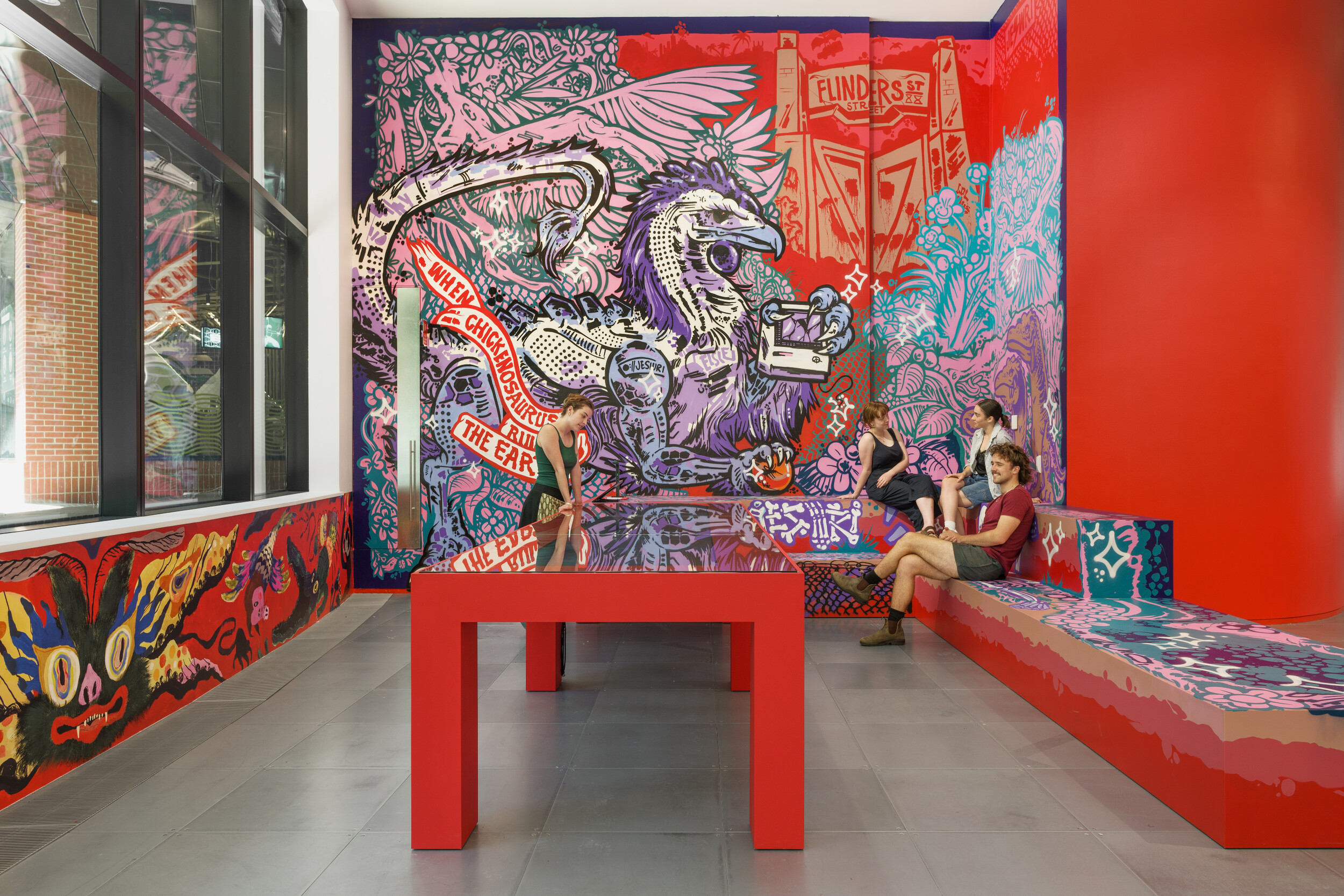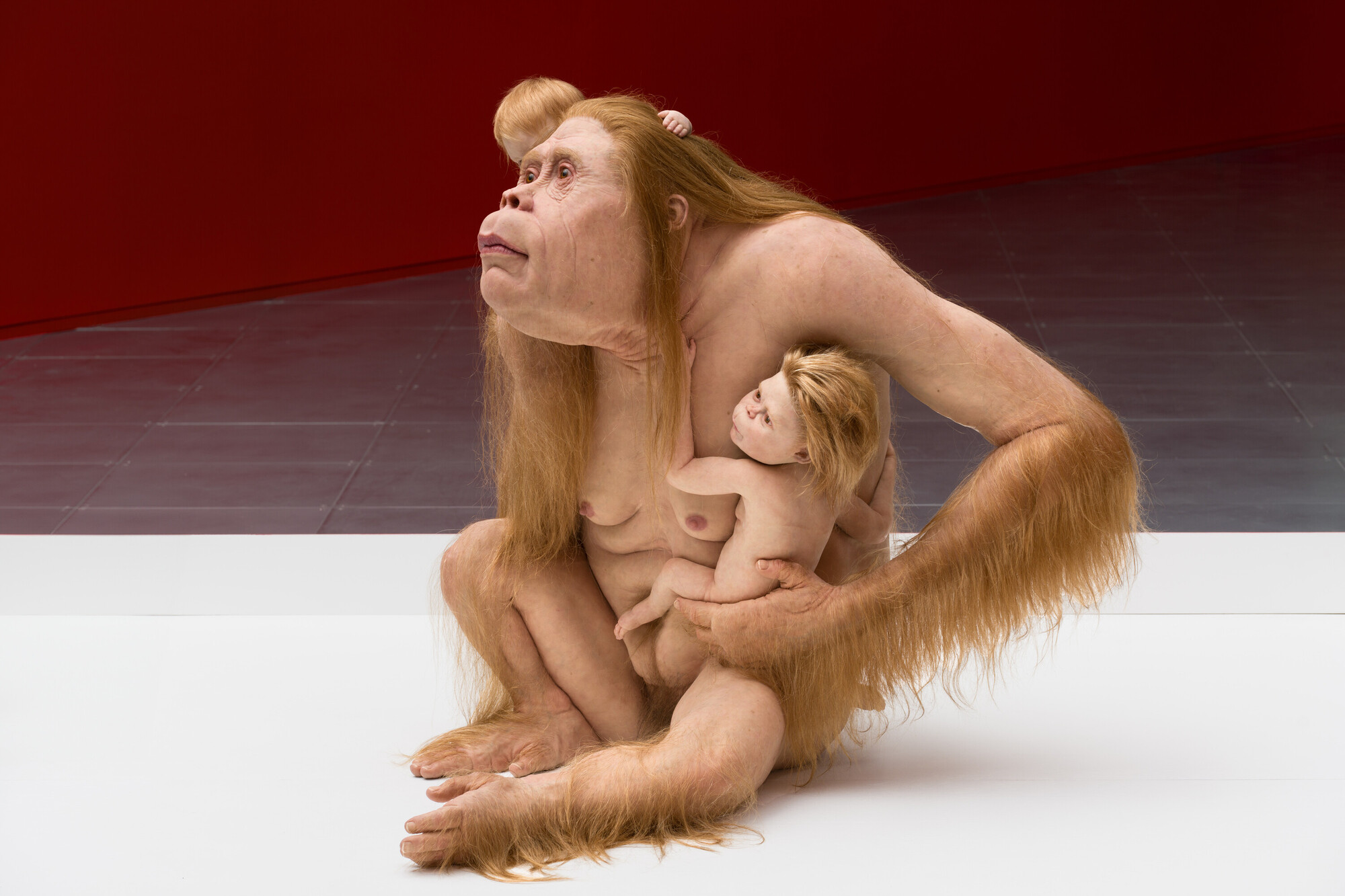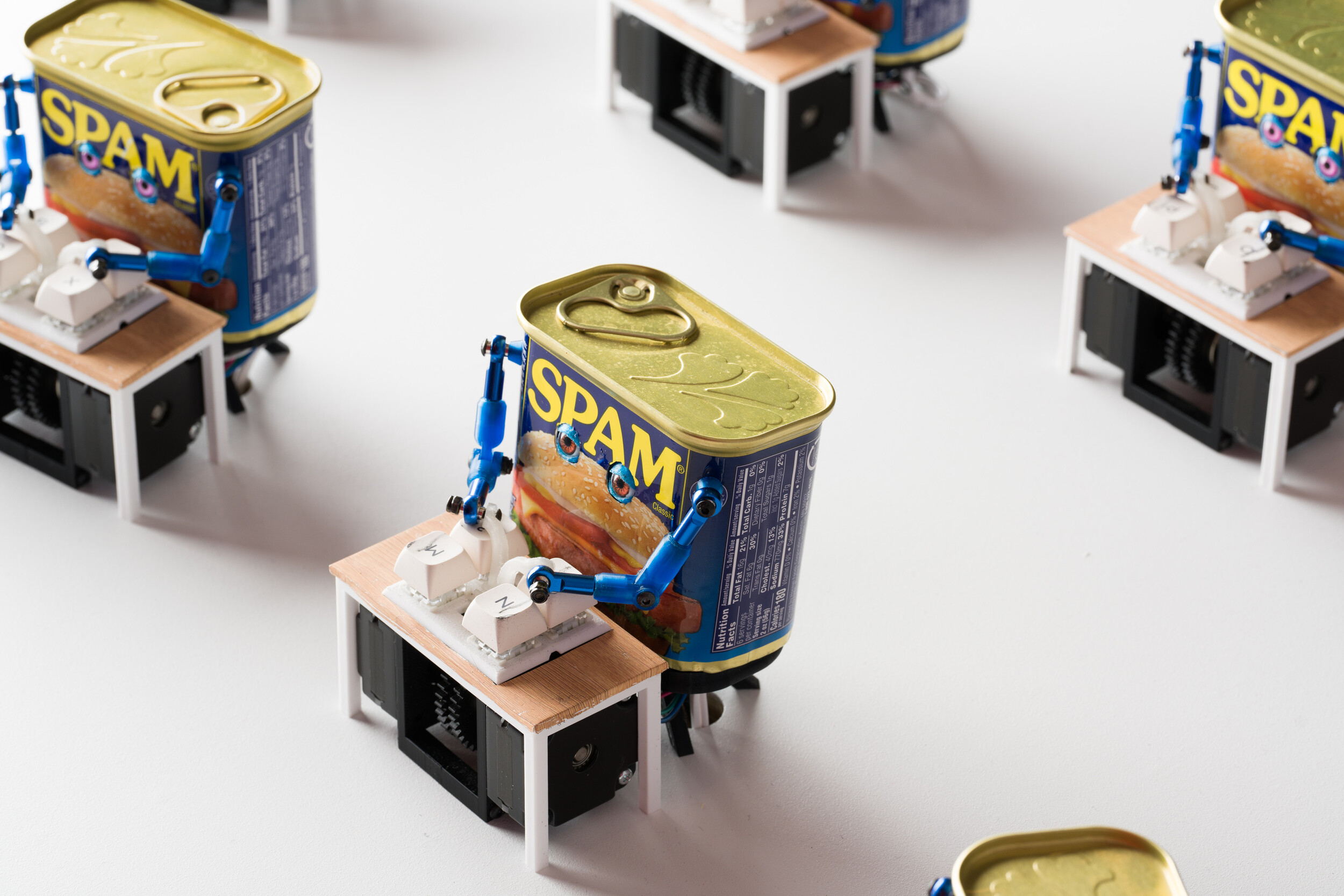Not Natural
Diego Ramirez
We need to talk about Science Gallery Melbourne. It sits opposite “Melbourne Connect,” the University of Melbourne’s new development. On the corner of Grattan and Swanston Street in Parkville, it is dedicated to housing a range of companies “of all scales and stages.” Of course, they call it a precinct and employ huge terms on their website like, “programmatic convergence,” “digital innovation ecosystem,” and “emerging technologies to disrupt and transform our society.” In my opinion, investors could have saved $425 million to transform society by turning the university into a non-profit organisation that focuses on improving the creation and transmission of equitable knowledge. However, I’m just an occasional Memo writer, not a scientist in Melbourne Connect’s “dynamic community of innovators,” helping to make the world a more irritating place with OpenAI—I mean, a better place.
Science Gallery Melbourne is the quirky neighbour in this master planning, showing the wider community of the University of Melbourne that scientific and technological progress can be fun too. While the gallery is incredibly outward facing, bearing a large window facade and a massive sign, I find it strangely easy to miss. Every time I visit the space, I take the wrong turn in the brick building that contains it, finding myself lost in front of Master Lanzhou Noodle Express, because everything looks the same (big glass windows in a brick building).
Science Gallery Melbourne, part of the University of Melbourne’s wider Museums & Collections department, hosts two exhibitions per year at the “collision of art and science,” with the aim to specifically engage “15–25 year-olds with science.” It is part of their Cultural Commons strategy, previously tackled by Tara Heffernan and Scott Robinson in Collective Unease in Memo, which according to their public strategic plan (2020–25) seeks to “activate and amplify our collective power to address the great challenges of our time” and promises “an enriched social and intellectual life that is creatively courageous.” The semblance between this kind of corporate speech and the sort uttered by artists pretending to work under a radical premise of collectivity speaks for itself: the creative sector is neoliberalism incarnate (especially the subset that pretends not to be). The strategic plan’s clunky subheading is noteworthy, as it reads “what we value, hold, discover, and create and what collectively helps us to understand what it means to be human.” The increasing corporatisation of everything, including real estate is one of the greatest challenges of our time, making Melbourne Connect an ideal site to feel the might of property speculation. Fear not, the great and powerful Science is here to save you.
The exhibition Not Natural at Science Gallery Melbourne looks at the possibilities of new hybrid species, envisioning a speculative collapse of artificial and natural biology. I don’t want to come across as pedantic, but their exhibition statement really needs an edit. As soon as I enter the gallery, I encounter a large banner introducing the exhibition with a frenetic text that touches on ethics briefly in the second sentence, only to ignore this complex line of thought by the third, where it becomes a redundant statement about how technology enables conformity. Moving on to a paranoid claim about artificial intelligence overtaking humanity. The part that really bothered me was the excessive rhetorical questions, such as “Are we redesigning evolution or is evolution re-designing us?” (I don’t know! Is it?) There are fifteen artists in the show, curated by a panel of seven curators, which makes me way more concerned for bureaucracy than AI. The best part is—and I dare you to come up with a better label—a content warning that reads: “Contains sensory experiences, live jellyfish and a machete-wielding houseplant.”

The first work is an installation called Chickenosaurus comprised of murals by various artists, including JESWRI, Andy Frazer, Freda Chiu and Gorkie. I struggle to identify the contribution of each artist (I could be pressing the wrong button), but at least the gallery provides their Instagram handle, allowing me to cross-check their posts. The most striking element is a wall painting by illustrator Freda Chiu, depicting a range of fantasy creatures with slightly nightmarish strokes. This includes a bat with moth wings, a frog with the body of a snake and a spider with sheep’s wool. These chimerical entities are floating over a red background, which contributes to their cute yet unsettling quality. There’s also a vitrine with an interactive screen that allows visitors to draw their own chimera. Unfortunately, the screen is frozen in a perpetual state of “uploading” that prevents me from creating my own hybrid monster.
I’m looking at the realistic mural of an egg hatching a chickenosaurus by paleo-artist Andy Frazer, when I notice a visitor guide (they’re called Mediators here, more on that later) explaining Patricia Piccinini’s hyperreal sculpture Kindred (2018) to a diverse group of twenty-year-olds. Kindred shows a humanoid chimpanzee in silicone and fibreglass holding her children. The realism of the sculpture and the babies creates a sense of empathic connection that heightens the uncanny effect of the figures. Staring into their glassy eyes is like gazing at a fresh corpse, as we search for connection where there is nothing but a shallow emptiness. The visitor guide explains the sculpture in more complex terms, by relating it to the commerce of gender. This makes me envious of their insights and prompts me to write an insecure observation in my notes that describes them as smarmy. At this point, I realise how well attended the exhibition is, even though I’m here on a Wednesday, indicating that Science Gallery Melbourne is delivering good metrics. One of their targets is to engage young audiences and they are clearly succeeding.

Staring at Piccininis’s Kindred, located prominently on a plinth midway through the gallery, gives me a panoramic view of the entire exhibition space, resembling the design of an expo or fair rather than a contemporary art exhibition. I initially ascribe this semblance to the various clusters of people looking at display cubicles, where novelty appears to dictate the engagement, rather than the critical premise that motivates art viewing. Yet there is something else contributing to this fair-life atmosphere that eludes my initial assessment. Searching for this source of discomfort, I notice how the artwork didactics—displayed on flat screens emitting an uncomfortable blue light (thanks, Science), are missing conventional information like the year of creation and mediums used. I wonder if I’m pressing the wrong button or if the gallery really overlooks such fundamental details. The absence of mediums prevents me from contextualising and interpreting the objects presented as worthy of contemplation. This suggests that something beyond the art itself is being showcased—the complex forces of Science and corporatisation, perhaps. Yet this doesn’t explain the fair or expo feeling.

Eventually I encounter Neil Mendoza’s Spambots (2023), a kitschy installation featuring a set of anthropomorphic cans of spam typing away at keys in front of a screen. The monitor displays Aldous Huxley’s dystopian novel Brave New World (1932), in a green font reminiscent of The Matrix (1999). Somehow, this is all connected with artificial intelligence, with the spam cans replacing words in the novel with references to pigs. The accompanying didactic suggests that Spambots offers a commentary on industrial farming by giving these canned hams “a voice of sorts.” However, the leap from industrial farming to spam is so puzzling, that I convince myself there must be more than linguistic opportunism at play here. I wonder if the fault is mine, for failing to locate a mode of signification that actually ties these semantics in a political manner with critical depth, as prescribed. While I’m struggling with this sense of confusion, someone approaches me to ask, “I see this work puts a smile on your face, why does it put a smile on your face?”
It is a contrived question from a friendly stranger wearing a Science Gallery Melbourne t-shirt, which suddenly helps me realise the source of the exhibition’s fair-like ambiance. The gallery has something they call Mediators, supported by the chemical company BASF, instead of invigilators. These amicable Mediators engage in dialogue with small groups of people around the works, resembling the dynamics of a fair, where an exhibitor addresses the display. The gallery’s website describes them as “communicators, explainers, listeners, and helpers.” This perfectly reflects a corporate commons mindset, using managerial tactics to shape spectator experience under the guise of cultural accessibility. Their argument is that these Mediators foster a social and democratic experience for customers (I mean, patrons). The fact that they converse rather than explain implies a sense of shared ownership over the art—this is “our” art, not just the institution’s. In contrast with the conventional museum guide, who imparts institutional knowledge about “their” art to visitors. Let me tell you a secret: this is not a library, you can’t borrow the art and take it home, so it is not yours nor mine. It’s such a constructed and performative shift that it’s kinda funny. Of course, I say this with respect for the people who are actually embodying these roles, but it feels like I’m in JB Hi-Fi, where everyone happens to be really eager to help me.
The concept of having Mediators reflects a historical tension between two approaches to institutional oversight, established by practices at the British Museum and the Royal Academy during the eighteenth century. Helen Rees, in her book Museum Bodies: The Politics and Practices of Visiting and Viewing, highlights the guided tour system employed by the British Museum, where staff members led small groups of scheduled (and ticketed) visitors through the collections, providing explanations of the art. This practice stemmed from class prejudice, with the institution fearing uneducated visitors might damage the art or create an undesirable atmosphere. Consequently, visiting the British Museum necessitated scheduling and paying for a guided tour rather than freely exploring the galleries. It sounds constraining now, and it was constraining then, as Helen Rees proves by including excerpts from several people complaining about this system, illustrating its restrictive nature both then and now. In contrast, the Royal Academy permitted unmoderated visits, a practice more akin to contemporary museum viewing today, enabling a social yet autonomous experience with art.
Science Gallery Melbourne ’s decision to hire Mediators is surely operating under the theatrical premise of shifting towards a more inclusive and interactive approach to museum engagement, by encouraging horizontal exchanges. While conventional museums focused on delivering information to visitors, Science Gallery Melbourne emphasises the importance of listening to them. You know, they want to place agency back on the audience (and you can finish this sentence in your mind however you like, as arts organisation broadcast endless variations of this sentiment every day). However, this act of listening is so carefully orchestrated that one immediately suspects the conventions of customer service and diversity work are at play, reflecting the wider corporatisation and bureaucratisation of everything. After all, a multinational directly funds this initiative.

This idea of granting agency circles back to Plant Machete by David Bowen, a robotic arm holding a machete attached to a philodendron. The work reads electrical noises from the plant that activate the robotic arm, causing the machete to twist and strike. It is a rather predetermined form of agency, limited to the prescribed notion and assumption that a plant may want to participate in this artwork at all, which is counter to autonomy. The work is also tainted, in my view, by a gallery wall label that reads, “The machete used in this artwork is blunted and in no way condones violence of any kind.” I can hear the echoes of anxious meetings assessing the liabilities of showing a machete so clearly in this sentence that I’m compelled to praise them for showing it at all. The warning label diverts attention from the artist’s concept, highlighting how using a machete to represent agency is hilariously at odds with the limitations of safe spaces, as the work operates under a premise of … let’s call it “violent communication.” This contradicts the tenets of feelings and needs that animate most contemporary art spaces in their performance of empathy and power distribution today.
Diego Ramírez is an artist with dreams, a writer with hopes and a facilitator with beliefs. He is represented by MARS Gallery and is currently undertaking a PhD at Monash University.


